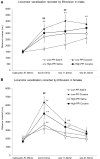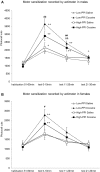Prepulse Inhibition of the Startle Reflex as a Predictor of Vulnerability to Develop Locomotor Sensitization to Cocaine
- PMID: 32116585
- PMCID: PMC7008852
- DOI: 10.3389/fnbeh.2019.00296
Prepulse Inhibition of the Startle Reflex as a Predictor of Vulnerability to Develop Locomotor Sensitization to Cocaine
Abstract
Prepulse inhibition (PPI) of the startle reflex is a measure of sensory-motor synchronization. A deficit in PPI has been observed in psychiatric patients, especially those with schizophrenia and vulnerable subjects, since the neural bases of this disorder are also involved in the regulation of PPI. Recently, we have reported that baseline PPI levels in mice can predict their sensitivity to the conditioned reinforcing effects of cocaine in the conditioned place preference (CPP) paradigm. Mice with a low PPI presented a lower sensitivity to the conditioned rewarding effects of cocaine; however, once they acquired conditioned preference with a higher dose of the drug, a more persistent associative effect of cocaine with respect to environmental cues was evident in these animals when compared with High-PPI mice. Therefore, we proposed that the PPI paradigm can determine subjects with a higher vulnerability to the effects of cocaine. Developing locomotor sensitization after pre-exposure to cocaine is considered an indicator of transitioning from recreational use to a compulsive consumption of the drug. Thus, the aim of the present study was to evaluate whether subjects with a low PPI display a higher locomotor sensitization induced by cocaine. First, male and female OF1 mice were classified as High- or Low-PPI according to their baseline PPI levels. Subsequently, the motor effects induced by an acute dose of cocaine (Experiments 1 and 2) and the development of locomotor sensitization induced by pre-exposure to this drug (Experiments 3 and 4) were recorded using two apparatuses (Ethovision and actimeter). Low-PPI mice presented low sensitivity to the motor effects of an acute dose of cocaine, but a high increase of activity after repeated administration of the drug, thus suggesting a great developed behavioral sensitization. Differences after pretreatment with cocaine vs. saline were more pronounced among Low-PPI subjects than among High-PPI animals. These results endorse our hypothesis that the PPI paradigm can detect subjects who are more likely to display behaviors induced by cocaine and which can increase the risk of developing a cocaine use disorder. Herein, we further discuss whether a PPI deficit can be considered an endophenotype for cocaine use disorder.
Keywords: behavioral sensitization; biomarker; cocaine; endophenotype; male and female mice; motor effects; prepulse inhibition.
Copyright © 2020 Arenas, Blanco-Gandía, Miñarro and Manzanedo.
Figures




Similar articles
-
Baseline prepulse inhibition of the startle reflex predicts the sensitivity to the conditioned rewarding effects of cocaine in male and female mice.Psychopharmacology (Berl). 2018 Sep;235(9):2651-2663. doi: 10.1007/s00213-018-4959-8. Epub 2018 Jun 29. Psychopharmacology (Berl). 2018. PMID: 29955900
-
Prepulse inhibition can predict the motivational effects of cocaine in female mice exposed to maternal separation.Behav Brain Res. 2022 Jan 7;416:113545. doi: 10.1016/j.bbr.2021.113545. Epub 2021 Aug 23. Behav Brain Res. 2022. PMID: 34437938
-
[Effects of cocaine on prepulse inhibition of the startle response].Rev Neurol. 2017 Dec 1;65(11):507-519. Rev Neurol. 2017. PMID: 29178109 Review. Spanish.
-
Impact of baseline prepulse inhibition on nicotine-induced locomotor sensitization in rats.Behav Brain Res. 2011 Jan 1;216(1):275-80. doi: 10.1016/j.bbr.2010.08.004. Epub 2010 Aug 12. Behav Brain Res. 2011. PMID: 20708641
-
Human studies of prepulse inhibition of startle: normal subjects, patient groups, and pharmacological studies.Psychopharmacology (Berl). 2001 Jul;156(2-3):234-58. doi: 10.1007/s002130100810. Psychopharmacology (Berl). 2001. PMID: 11549226 Review.
Cited by
-
Prepulse Inhibition in Cocaine Addiction and Dual Pathologies.Brain Sci. 2021 Feb 20;11(2):269. doi: 10.3390/brainsci11020269. Brain Sci. 2021. PMID: 33672693 Free PMC article.
-
Evaluation of Sensorimotor Gating Deficits in Mice Through Prepulse Inhibition (PPI) of the Startle Response.Methods Mol Biol. 2023;2687:57-64. doi: 10.1007/978-1-0716-3307-6_5. Methods Mol Biol. 2023. PMID: 37464162
References
-
- Allain F., Roberts D. C. S., Lévesque D., Samaha A. N. (2017). Intermittent intake of rapid cocaine injections promotes robust psychomotor sensitization, increased incentive motivation for the drug and mGlu2/3 receptor dysregulation. Neuropharmacology 117, 227–237. 10.1016/j.neuropharm.2017.01.026 - DOI - PubMed
-
- Arenas M. C., Navarro-Francés C. I., Montagud-Romero S., Miñarro J., Manzanedo C. (2018). Baseline prepulse inhibition of the startle reflex predicts the sensitivity to the conditioned rewarding effects of cocaine in male and female mice. Psychopharmacology 235, 2651–2663. 10.1007/s00213-018-4959-8 - DOI - PubMed
LinkOut - more resources
Full Text Sources

